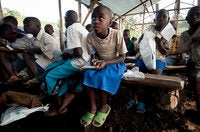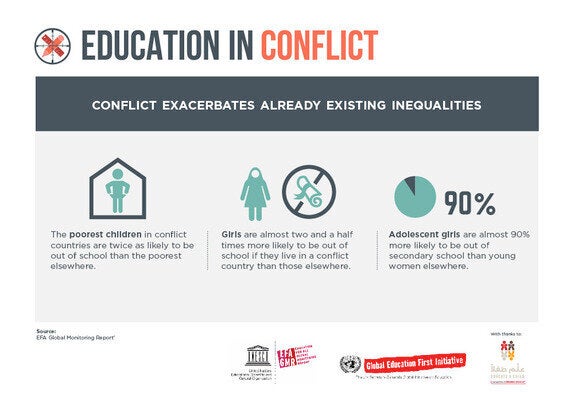Trying to understand how humanitarian aid to education works in a crisis is like trying to plough your way through a complicated list of equations that don't add up. Even if they do, the results do not meet commonsense expectations at all - just what you need when it's an emergency and you need funds, predictable ones, and fast.
This is the conclusion of a new paper out by the EFA Global Monitoring Report, published by UNESCO. Analysing the current system of humanitarian aid requests and dispersements, it shows a series of unfair and ineffective distribution mechanisms that leave millions without the support in education they urgently need.

Let's take 2013 as an example year. Humanitarian-oriented organizations identified 21 million children and youth as needing support for education, but appeals only called for funds to help reach 8 million of them. Given that education is so far down the pecking order in times of crisis and that appeals are inadequately funded, in the end only 3 million people received support. This meant that no fewer than 18 million children and youth were without education support at all. That's right - 18 million.
Equally problematic - and unfair - is the way costs are tallied up in appeals, and the way funds are eventually doled out. An appeal in Yemen calls for $3 per child, as compared to $235 per child in an appeal for the Central African Republic, for instance. What is the logic behind such requests?
Media attention appears to play a role in this process: over half of available humanitarian aid to education between 2000 and 2014 was allocated to just 15 out of 342 appeals - all of them high profile global emergencies covered extensively by the media. Many other countries, meanwhile, such as the Democratic Republic of Congo, which has had an ongoing emergency for over a decade, received pittance in comparison to new emergencies just hitting the news.
Even if the true needs of children and youth were identified, and there was no bias in funding requests and allocations, education still suffers from not being seen as a critical component in the first wave response to a crisis. Health, and nutrition are prioritized; teachers and school infrastructure, if placed on the agenda, come later. News coverage follows the same format, citing numbers who have died, the lack of food and relief packages and then, and only then, the need for rebuilding schools and classrooms and a return to normality.
But is normality so unimportant? Put yourself in the shoes of a child suddenly uprooted, separated from their daily routines with schoolmates and family members. Immediate, regular, structured class-time, in child-friendly spaces, with teachers properly trained in psycho-social support would give huge relief from an otherwise threatening and unstable life going on outside.
Education should not, therefore, be an afterthought for those who are caught up in the devastating web of a crisis. It certainly should receive more than the paltry 2% of humanitarian aid it received in 2014.
For those who need further convincing, consider the evidence: being out of school in times of conflict takes a heavy toll on children's health and wellbeing. Conflict also exacerbates already existing inequalities, making life even harder for the poorest, and for girls. The poorest are twice as likely to be out of school in conflict-affected countries as their counterparts in other countries. Girls are over two and a half times more likely to be out of school in conflict zones than not.

These are global averages, for sure, and may bear little resemblance to realities on the ground. But country level examples show the same story. Children living in conflict-affected regions in Ethiopia, for instance, are five times less likely to complete primary school than those in unaffected regions.
These children definitely need our support. And assigning a percentage of aid is not necessarily going to cover these needs, given that we don't know the scale of future crises, and we can't guarantee how much aid is likely in the pot. Our paper has clearly shown that the currently used target of '4% of humanitarian aid to education' is grossly insufficient: in 2013 it would have left over 15 million people with no assistance at all. We should clearly be aiming higher than we have been. It's time to rethink what we've been calling for.
A far better target is to aim to ensure each and every child and youth has enough funds to ensure them a quality education when crisis hits. For this, we urgently need a consistent and fair needs assessment for education in emergencies. After considering domestic resources, the EFA Global Monitoring Report has calculated that, on average, at least $38 for each child, and $113 for each adolescent, is needed to provide them with an equitable and quality education. This equates to $2.3 billion or ten times the amount that education currently receives from humanitarian aid. This is the sum that should guide development and humanitarian finances in times of emergency, nothing else.
It's complicated, and we face a huge challenge to attract greater funds for schooling and teaching in conflict. But that shouldn't scare us off. The needs are huge, and we must use that as inspiration, rather than as a barrier, to our ambitions. Education cannot wait in times of an emergency. We have no time to lose.
